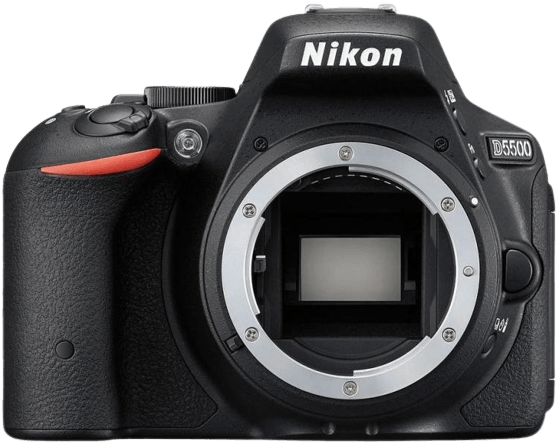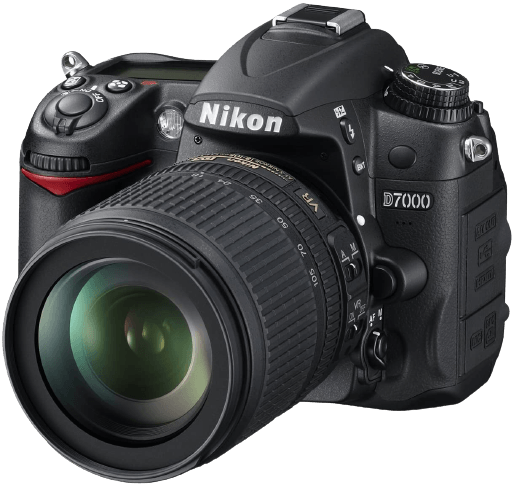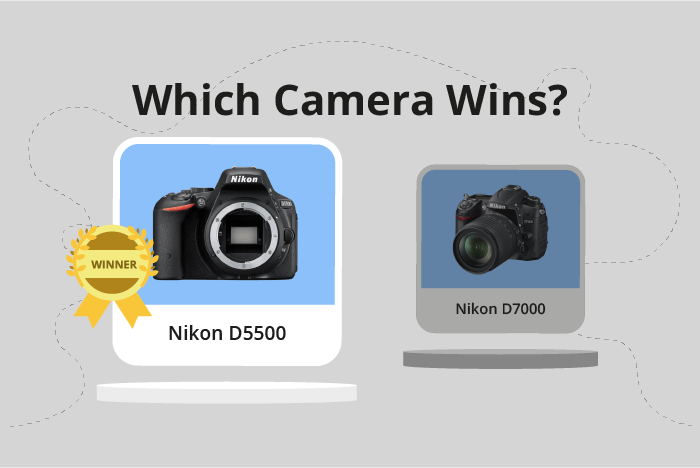Nikon D5500 vs D7000 Comparison
Nikon D5500

Nikon D7000

The Nikon D5500 outperforms the Nikon D7000 with a score of 61/100 compared to 56/100. Both cameras are DSLR models, released in 2015 and 2010 respectively. They share some common specifications, such as camera type and the brand.
The D5500 has advantages over the D7000, including a smaller size (124 x 97 x 70mm) and a lighter weight (420g / 0.93lbs). These features make the D5500 more affordable and portable.
On the other hand, the D7000 does not have any significant advantages over the D5500. This makes the Nikon D5500 a better choice due to its higher score, lower price, and more compact design.
Nikon D5500 vs D7000 Overview and Optics
The Nikon D5500 outperforms the Nikon D7000 in optics, scoring 65/100 compared to the D7000’s 55/100. Both cameras share some common specifications, such as the CMOS sensor type, APS-C sensor size, Nikon lens mount, and lack of image stabilization.
The D5500’s superiority in optics can be attributed to higher megapixels (24.2 vs. 16.2), a more advanced processor (Expeed 4 vs. Expeed 2), and a better DXOMARK score for the sensor (84 vs. 80). These factors contribute to the D5500’s ability to capture higher resolution images and process them more efficiently, resulting in better overall image quality.
On the other hand, the D7000 has a faster shooting speed (6 fps vs. 5 fps), which may be advantageous for action photography or capturing fast-moving subjects. However, this advantage is not enough to outweigh the benefits of the D5500’s superior optics.
Taking into account the specifications and performance of both cameras, the Nikon D5500 emerges as the better option for photographers prioritizing image quality and resolution. The D7000’s faster shooting speed may be attractive to some users, but it falls short in other aspects, making the D5500 the more versatile and capable choice for a wide range of photographic needs.
Nikon D5500 vs D7000 Video Performance
The Nikon D5500 is the winner in video capabilities, with a score of 70/100 compared to the Nikon D7000’s score of 57/100. Both cameras share some common specifications, including Full HD video resolution, maximum video dimensions of 1920 x 1080, and built-in time-lapse functionality.
The D5500 outperforms the D7000 in video frame rate, offering a maximum of 60fps, while the D7000 only reaches 24fps. This higher frame rate allows the D5500 to capture smoother and more detailed video, especially in fast-paced scenes or when recording sports and action events. This advantage makes the D5500 more suitable for videographers who require more flexibility in capturing fast-moving subjects.
On the other hand, the D7000 does not offer any significant advantages over the D5500 in terms of video capabilities. Both cameras share the same video resolution and dimensions, as well as time-lapse functionality. Therefore, the D7000’s lower video score is mainly due to its limited frame rate compared to the D5500.
Considering the 13-point difference in video scores and the higher frame rate offered by the Nikon D5500, it is evident that the D5500 is the superior choice for videographers who prioritize video capabilities. The Nikon D7000, while still offering decent video performance, falls behind the D5500 in this aspect and may not be the best choice for those who require high-quality video recording.
Nikon D5500 vs D7000 Features and Benefits
The Nikon D5500 outperforms the Nikon D7000 with a feature score of 59/100, compared to the latter’s 54/100. Both cameras share some specifications, such as the absence of GPS and Bluetooth connectivity. However, they both come with built-in WiFi, making it convenient for users to transfer photos and control the camera remotely.
The D5500 has a clear advantage in display features, offering a larger 3.2-inch screen with a higher resolution of 1,037,000 dots. This improved screen quality allows users to review images and navigate menus with greater clarity. Additionally, the D5500 is equipped with a touchscreen, which enables more intuitive control and quicker adjustments to settings. The flip screen feature on the D5500 also allows for more versatile shooting angles, making it a more flexible option for different photography situations.
On the other hand, the D7000 does not offer any significant advantages over the D5500 in terms of features. Its 3-inch screen has a lower resolution of 921,000 dots, and it lacks both touchscreen and flip screen capabilities. These shortcomings make the D7000 less user-friendly and adaptable compared to the D5500.
Given these differences, the Nikon D5500 emerges as a superior camera in terms of features. Its larger, higher-resolution touchscreen and flip screen provide users with better control and flexibility while shooting. The D7000, while still a reliable camera, falls short in these aspects, making the D5500 a more appealing choice for photographers seeking advanced features and convenience in their camera.
Nikon D5500 vs D7000 Storage and Battery
The Nikon D7000 outperforms the Nikon D5500 in storage and battery with a score of 79/100 compared to the D5500’s score of 35/100. Both cameras share similarities in storage options, accepting SD, SDHC, and SDXC cards. However, the D7000 takes two memory cards instead of a single card. The D7000 also takes the lead in battery life, offering 1050 shots per charge with its EN-EL15 battery, while the D5500 provides 820 shots using an EN-EL14 battery. Neither camera supports USB charging.
Despite the D5500’s lower score, it still delivers a decent battery life for casual photography. Nevertheless, the D7000’s longer battery life and the use of a more powerful battery make it a more suitable choice for extended shooting sessions or professional use. The storage options are identical, so both cameras meet standard expectations for memory card compatibility.
Alternatives to the Nikon D5500 and D7000
Are you still undecided about which camera is right for you? Have a look at these popular comparisons that feature the Nikon D5500 or the Nikon D7000:

